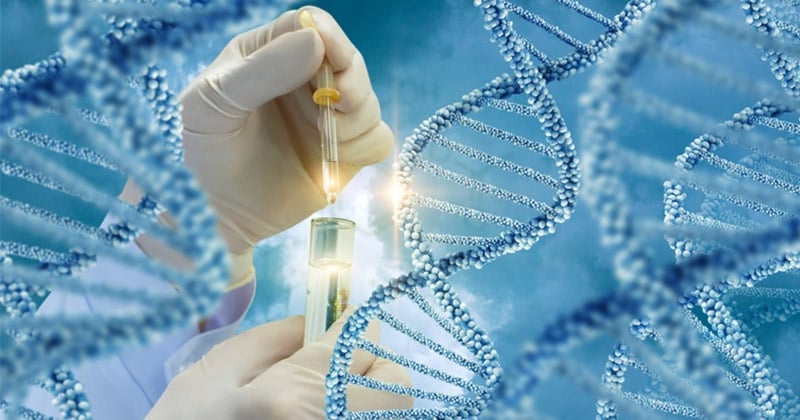- Deoxyribonucleic acid (DNA) extraction is the process by which DNA is separated from proteins, membranes, and other cellular material contained in the cell from which it is recovered.
- In eukaryotic cells, such as human and plant cells, DNA is organized as chromosomes in an organelle called the nucleus.
- These cells also have a lipid bilayer outer membrane and cytoplasm containing proteins, sugars, lipids, and inorganic ions of various types and function. Eukaryotic cells also contain other membrane-enclosed compartments called organelles.
- Hence, for the isolation of DNA from these cells, the three basic steps necessary include:
1) Lysis
2) Precipitation
3) Purification

Interesting Science Videos
Principle of Eukaryotic DNA Isolation
The first step in DNA isolation is the cell lysis in which the cell and the nucleus are broken open to release the DNA inside. This can be achieved be either mechanical disruption methods (using a tissue homogenizer (like a small blender), a mortar and pestle, by cutting the tissue into small pieces) or through lysis using detergents and enzymes such as Proteinase K to free the DNA and dissolve cellular proteins. An extraction buffer is often employed in the process consisting of 50mM Tris, pH 8, 25mM EDTA, 200 mM NaCl, 1% SDS etc.
- The Tris buffer helps in pH maintenance.
- EDTA binds divalent metal ions (Ca2+, Mg2+, Mn2+) that could form salt with anionic PO43-group of DNA. It also destabilizes the cell membrane, prevents precipitation of DNA and inhibits DNAses.
- NaCl help loosen the cell wall for increased solubility and stability of DNA. It also enables DNA to precipitate out of an alcohol solution because it shields the negative phosphate end of DNA, causing the DNA strands to come closer together.
- SDS which is an anionic detergent disrupts ionic interaction between proteins.
- Liquid detergent causes cell membranes to break down by emulsifying the lipids and proteins of the cell and disrupting the bonds that hold the cell membrane together. The detergent also causes the lipids and proteins to precipitate out of the solution.
- DNA released from disrupted cells is finally precipitated by cold absolute ethanol or isopropanol.
- DNA is soluble in dish detergent solution but insoluble if ethanol is added. Adding alcohol precipitates the DNA that is it causes every component in the filtrate to stay in solution except the DNA.
Materials and Reagents of Eukaryotic DNA Isolation
- 5mL microcentrifuge tubes
- Water bath 80oC
- Isopropanol (room temperature)
- 70% ethanol (room temperature)
- Lysis solution
- RNAse solution
- Protein Precipitation Solution
- Absorbent paper
Procedure of Eukaryotic DNA Isolation
- Depending upon the sample at hand (animal cell or plant cell), perform cell lysis.
- Add 3µL of RNase solution to the lysate
- Invert the tube 2-5 times to mix sample
- Incubate mixture at 37oC (15-30 min)
- Cool to room temp for about 5 minutes
- Add 200µL of protein precipitation solution and vortex at a high speed (20 seconds).
- Chill sample for about 5 minutes
- Centrifuge at 13,000-16,000 x g (4 min)
- On formation of a white pellet, remove the supernatant.
- Transfer DNA in 1.5mL microcentrifuge tube w/ 600µLof room temp. Add isopropanol into the tube for precipitation.
- Invert tube gently to mix solution.
- White thread- like strands of DNA form a visible mass
- Centrifuge at13,000-16,000 x g (at room temperature for 1 min)
- On formation of a small white pellet, decant the supernatant
- Add 100µL of room temp.70% ethanol
- Invert tube several times (washing of the DNA)
- Centrifuge at13,000-16,000 x g ( at room temperature for1 min)
- Aspirate ethanol
- Invert tube on a clean absorbent paper
- Air-dry pellet (10-15 minutes)
- Add 100µL of DNA Rehydration Solution
- Incubate at 65oC for 1 hour (Rehydration of DNA)
- Store DNA(2-8o C)
- DNA concentration can be determined measuring the intensity of absorbance of the solution at the600 nm with a spectrophotometer and comparing to a standard curve of known DNA concentrations. DNA absorbs UV light at 260 and 280 nm while proteins absorb UV light at 280 nm.
Expected Results of Eukaryotic DNA Isolation
White thread like strands or white pellet of DNA
On Spectrophotometry,
- Pure DNA = 1.8
- DNA with protein < 1.8
References
- https://www.ncbi.nlm.nih.gov/pubmed/3037944
- https://www.sciencedirect.com/topics/neuroscience/dna-extraction
- https://bioprep.community.uaf.edu/learning-modules/2-dna-extraction-4/the-basics-of-dna-extraction/
- https://www.scribd.com/doc/21423188/Isolation-of-DNA
- https://www.encyclopedia.com/science-and-technology/biology-and-genetics/genetics-and-genetic-engineering/dna-isolation-methods
- https://www.scribd.com/document/44958187/DNA-Extraction
- http://virtuallibrary.stao.ca/sci-tie-data/lessons/biology/b12/DNA_EXTRACTION_EXPERIMENTans.html
